Don't wanna be here? Send us removal request.
Text
Pure Georgette Chex Shibori Print Mirror Work Saree,




0 notes
Text
Pure Moonga Crape Patola Silk Printed Border Saree

0 notes
Text
Soft Desi Tussar Silk With All Over Laheriya Pattern Fancy Tassels Saree





0 notes
Text
Pure Gaji Silk Bandhani Ghatchola Gotapatti Work Bridal Style Dupatta

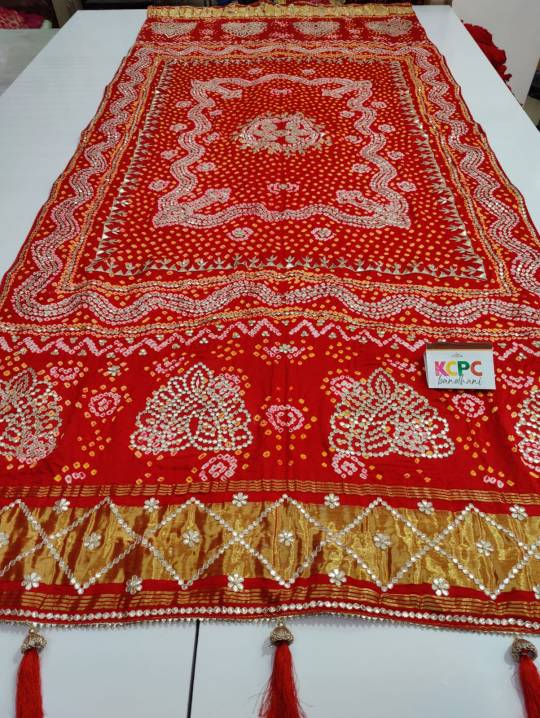
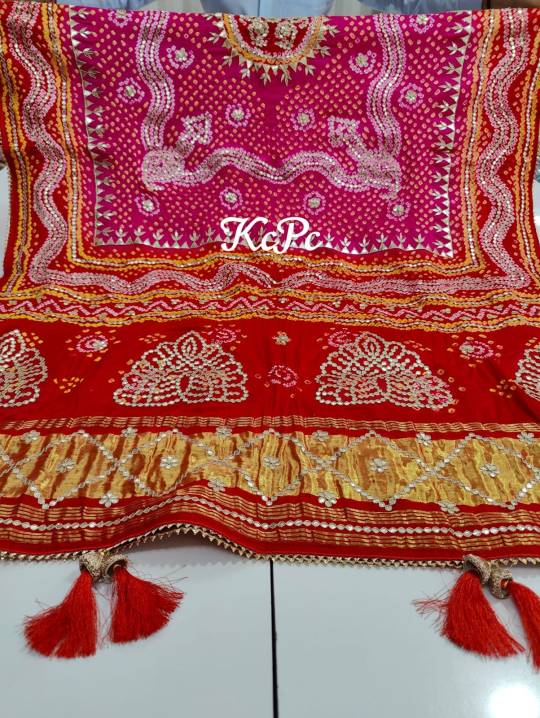
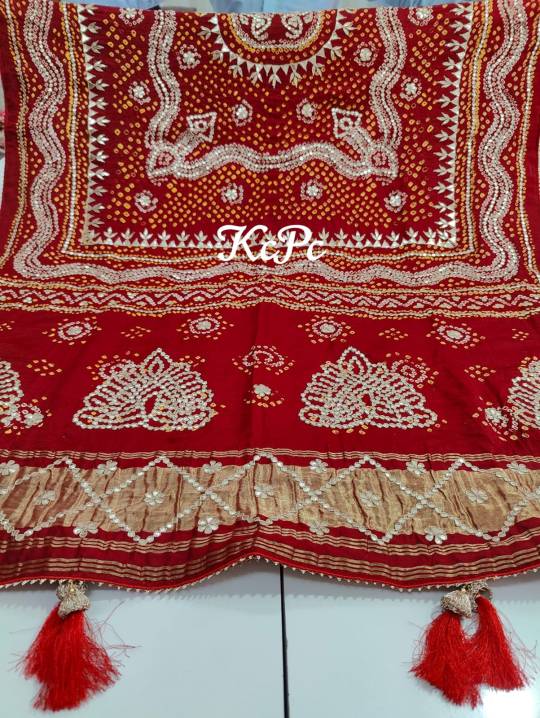
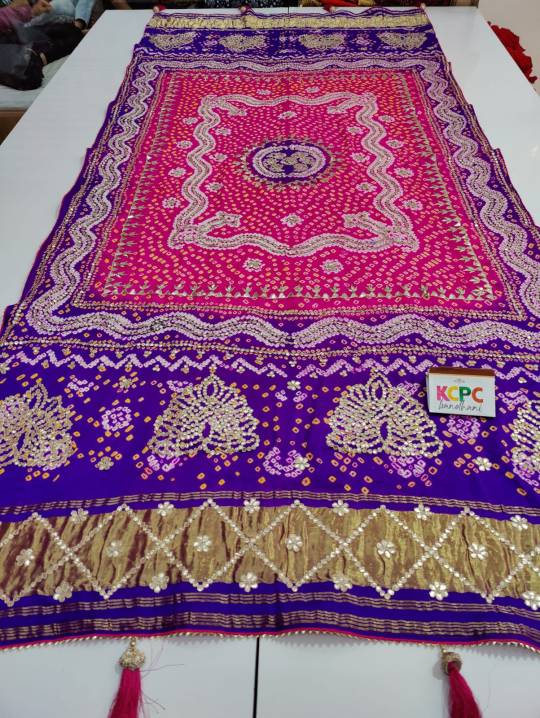


A bridal-style dupatta, meticulously crafted from pure Gaji silk, adorned with Bandhani Ghatchola patterns and embellished with intricate Gotapatti work, stands as an opulent and resplendent masterpiece of traditional Indian attire.
0 notes
Text
New Banarasi Jackard Silk Saree




0 notes
Text
Cotton Ghatchola Bikaneri Sarees




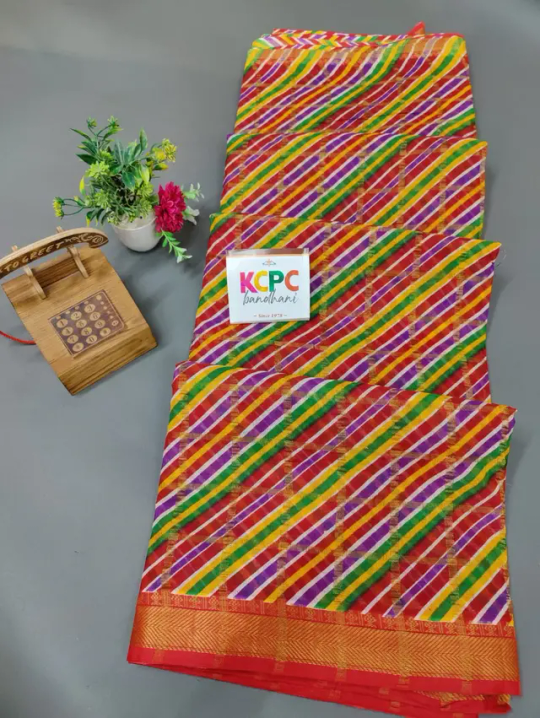




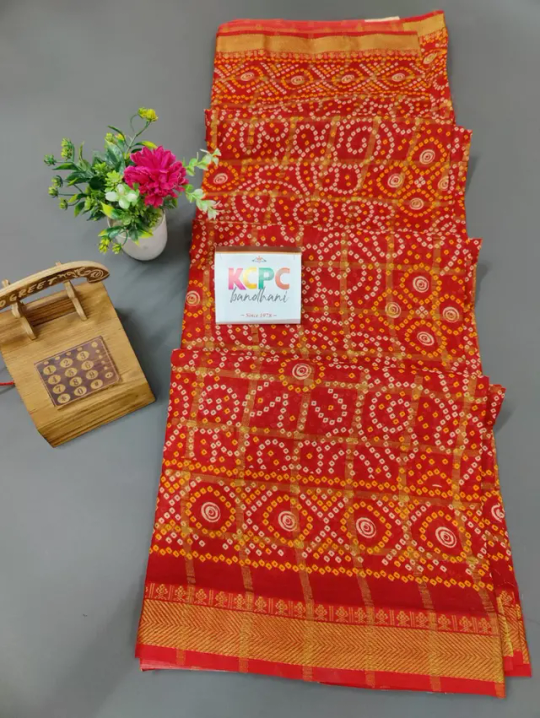

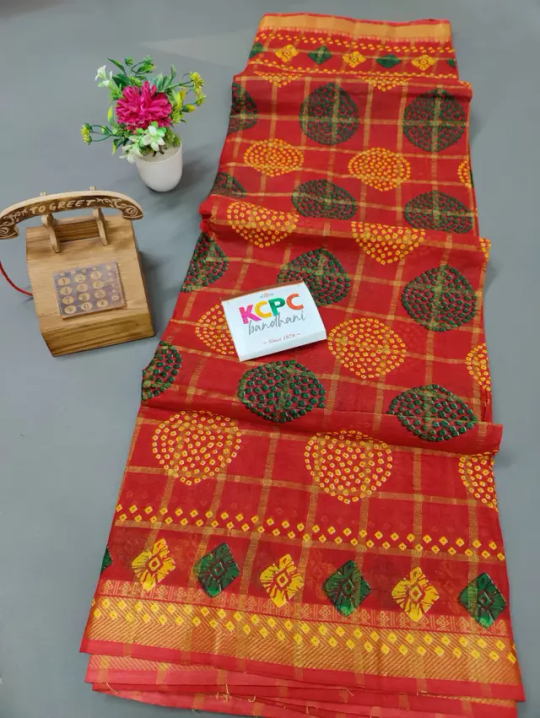
Cotton Ghatchola Bikaneri sarees are a specific type of traditional Indian saree known for their unique weaving technique, vibrant colors, and intricate patterns. Here's a closer look at these sarees:
1. Cotton Fabric: Cotton Ghatchola Bikaneri sarees are primarily made from cotton, a breathable and comfortable fabric that is well-suited for various weather conditions, especially in the hot and arid regions of Bikaner, Rajasthan.
2. Ghatchola Weaving Technique: What sets these sarees apart is the Ghatchola weaving technique used in their creation. Ghatchola is characterized by its distinctive geometric and floral patterns, which are created through a tie-dye resist process. The process involves tying portions of the fabric with thread before dyeing it, resulting in areas with different colors or patterns after dyeing and untying.
3. Vibrant Colors: Bikaneri sarees are known for their vivid and eye-catching colors. Traditional color combinations often include rich reds, vibrant blues, bright greens, and bold yellows. These colors are chosen to create a striking contrast between the dyed and undyed portions of the fabric, emphasizing the intricate patterns.
4. Geometric and Floral Motifs: The Ghatchola technique allows for the creation of intricate geometric and floral motifs on the saree. These motifs are a hallmark of Bikaneri sarees and are often visually captivating, with a sense of symmetry and balance.
5. Cultural Significance: Bikaneri sarees are an important part of the cultural heritage of the Bikaner region in Rajasthan, India. They are often worn by women during special occasions and festivals, such as weddings and religious ceremonies. These sarees are not only a symbol of cultural identity but also a form of artistic expression.
6. Handcrafted: The making of Cotton Ghatchola Bikaneri sarees is a labor-intensive process that involves skilled artisans. The tie-dyeing and weaving are done by hand, which adds to the uniqueness and authenticity of each saree.
7. Versatile: While Bikaneri sarees are traditionally associated with special occasions and celebrations, they can also be worn for everyday use due to the comfort of cotton fabric.
In summary, Cotton Ghatchola Bikaneri sarees are prized for their artistic craftsmanship, vibrant colors, and cultural significance. They are a testament to the rich textile traditions of Rajasthan and are cherished by women for their beauty and versatility. These sarees are not just garments but pieces of art that represent the heritage and creativity of the Bikaner region.
0 notes
Text
Pure Gajji Silk Bandhani Ghatchola Heavy Gotapatti Work Saree


The "Pure Gajji Silk Bandhani Ghatchola Heavy Gotapatti Work Saree" is a testament to the opulence, craftsmanship, and artistry that defines traditional Indian sarees. Let's delve into the intricate details that make this saree an embodiment of elegance:
Pure Gajji Silk: Gajji silk is the epitome of premium silk fabric, celebrated for its inherent richness and lustrous finish. When we say "pure," we emphasize that this saree is meticulously woven from entirely natural silk fibers, ensuring an unparalleled luxurious sheen.
Bandhani: Originating from the vibrant regions of Gujarat and Rajasthan in India, Bandhani is a time-honored tie-dye technique. It involves the meticulous process of tying small sections of the fabric with threads before the dyeing stage. This meticulous approach results in a mesmerizing tapestry of intricate and colorful patterns, composed of tiny, artful dots or "bandhs." Bandhani infuses the saree with a dynamic burst of color, showcasing the unmatched skill of the artisans.
Ghatchola: Within the realm of Bandhani, Ghatchola emerges as a distinctive style, revered for its expansive and elaborate patterns. These patterns often feature intricate motifs like peacocks, geometric shapes, blossoms, and more. Ghatchola Bandhani graces a significant expanse of the saree, rendering it visually captivating and awe-inspiring.
Heavy Gotapatti Work: Gotapatti work represents a form of embroidery that entails the careful attachment of minute metallic elements, reminiscent of gold or silver (known as "gotas"), onto the fabric. The term "heavy" signifies an abundance of such embellishments. The Gotapatti work on this saree exudes opulence and grandeur, with intricately designed floral, paisley, and ornamental motifs. This heavy embroidery elevates the saree to a regal status, making it the ideal choice for momentous cultural events, weddings, and formal gatherings.
A "Pure Gajji Silk Bandhani Ghatchola Heavy Gotapatti Work Saree" is not merely a piece of clothing; it is a masterpiece of Indian textile artistry and skill. It seamlessly melds the sumptuousness of pure silk, the complexity of Bandhani's vibrant patterns, the grandeur of Ghatchola's intricate designs, and the opulent beauty of heavy Gotapatti embroidery. These sarees are cherished adornments for significant occasions, where they make a resplendent statement and reflect the wearer's profound appreciation for India's rich textile traditions and aesthetics.
0 notes
Text
Pure Chiffon Multi Leheriya Gotapatti Work Saree
https://www.onlinebandhej.com/search?options%5Bprefix%5D=last&page=3&q=+designer+gotapatti+gaji+silk+febric+saree+kcpc+++&type=product

A Pure Chiffon Multi Leheriya Gotapatti Work Saree represents the quintessential essence of traditional Indian attire. Crafted from the finest chiffon fabric, renowned for its ethereal and graceful draping qualities, this saree encapsulates timeless elegance.
Let's delve into the details:
**Pure Chiffon:** Chiffon, a lightweight and translucent fabric, is celebrated for its inherent fluidity and gentle drape. When it comes to crafting sarees, pure chiffon reigns supreme, as it is fashioned from unadulterated, top-tier chiffon material.
**Multi Leheriya:** Hailing from the colorful tapestry of Rajasthan, India, Leheriya is an age-old tie-dye technique that weaves diagonal stripes and undulating waves of vibrant hues onto the fabric. "Multi Leheriya" signifies a symphony of colors, resulting in a saree that is resplendent with a kaleidoscope of shades, offering a visually captivating allure.
**Gotapatti Work:** Originating from the regal lands of Rajasthan, Gotapatti is an intricate form of embroidery. It involves the meticulous attachment of metallic pieces, resembling gold or silver (known as "gotas"), onto the fabric. This artistry breathes life into the saree with elaborate designs, often featuring floral motifs, paisleys, and other ornamental embellishments. Gotapatti work bestows an opulent opulence upon the saree, making it fit for royalty.
In essence, a Pure Chiffon Multi Leheriya Gotapatti Work Saree harmoniously merges the delicate allure of chiffon fabric with the vivid tapestry of multi-colored tie-dye patterns (Leheriya) and the opulent brilliance of intricate metallic embroidery (Gotapatti work). These sarees are coveted treasures, particularly gracing auspicious occasions such as weddings, festivals, and formal gatherings, both in India and across the globe, owing to their impeccable craftsmanship and resplendent charm.
0 notes
Text
Pure Ojariya Handwork Zardoji Kolkata Special Marwari Chunri Odhna



The description you've provided pertains to a piece of traditional Indian attire, specifically known as a "Marwari Chunri Odhna," distinguished by its unique characteristics. Let's dissect the elements within this ensemble:
Pure Ojariya Handwork: "Ojariya" typically denotes an intricate form of hand embroidery or handwork applied to fabric. This artisanal technique often incorporates vibrant threads, mirrors, and other embellishments to create intricate and decorative patterns. Thus, "Pure Ojariya Handwork" signifies that the Chunri Odhna (scarf) is adorned with this exceptional handcrafted detailing.
Zardozi: Zardozi represents a time-honored Indian embroidery method that employs metallic threads, frequently gold or silver, to craft intricate and opulent designs on fabric. It is renowned for its luxurious appeal and is commonly featured in attire designed for special occasions.
Kolkata Special: The term "Kolkata Special" implies that this Chunri Odhna may have been fashioned or sourced from Kolkata, renowned for its skilled artisans and adherence to traditional craftsmanship.
Marwari Chunri Odhna: A "Chunri Odhna" is an extended scarf or dupatta traditionally worn by women in various regions of India. The descriptor "Marwari" signifies a connection to the Marwari culture, predominant in the Rajasthan region of India. Marwari Chunri Odhnas are celebrated for their vivid hues and intricate designs, rendering them an integral component of traditional Marwari attire.
In essence, a "Pure Ojariya Handwork Zardozi Kolkata Special Marwari Chunri Odhna" is undoubtedly a meticulously crafted and resplendent scarf or dupatta, enriched with distinctive handcrafted embroidery techniques. It may have roots in Kolkata's artisanal excellence and reflects the quintessential style associated with the Marwari culture in Rajasthan, India. Such an accessory would undoubtedly elevate the charm of traditional Indian occasions and celebrations.
0 notes
Text
Pure Organza With Zari Weaving Work With Tassels Lehenga




The description you've provided pertains to a specific style of lehenga, a traditional Indian garment often favored for weddings, festivals, and other special events. Let's delve into the components that make up this ensemble:
Pure Organza: Organza, known for its lightweight and translucent qualities, is crafted from silk or synthetic fibers. "Pure Organza" signifies that this lehenga is fashioned from top-quality, unadulterated organza fabric, renowned for its exquisite and ethereal aesthetic.
Zari Weaving Work: Zari work entails the intricate weaving of metallic threads, typically gold or silver, into the fabric to form elaborate patterns and designs. Zari work imparts an opulent and lustrous allure to the lehenga.
Tassels: Tassels serve as ornamental embellishments, often gracing the edges or hem of both the lehenga and the blouse. These adornments can comprise threads, beads, or other materials, elevating the overall visual appeal of the ensemble.
Lehenga: The lehenga itself is a long, flared skirt, customarily accompanied by a blouse (choli) and a matching or contrasting dupatta (scarf). It stands as an integral component of traditional Indian attire, particularly cherished by brides and bridesmaids.
In summary, a "Pure Organza With Zari Weaving Work With Tassels Lehenga" epitomizes a resplendent Indian garment meticulously fashioned from premium organza fabric, featuring intricate metallic thread weaving (zari work) and enhanced with decorative tassels. Such a lehenga promises to be a captivating choice for special occasions and celebratory moments.
0 notes
Text
Pure Gaji Silk Ghatchola Beautiful Party Wear Saree


A "Pure Gaji Silk Ghatchola Beautiful Party Wear Saree" is a stunning and elegant Indian saree made from pure Gaji silk fabric and featuring the Ghatchola Bandhani design. Let's break down the elements of this description: Pure Gaji Silk: Gaji silk is a high-quality and luxurious silk fabric known for its fine texture, softness, and lustrous appearance. It is a popular choice for special occasions and party wear due to its premium quality. Ghatchola: Ghatchola, as mentioned earlier, refers to a specific type of Bandhani pattern characterized by large and bold designs, often with symmetrical arrangements. It is a visually striking and intricate tie-dye technique. Beautiful Party Wear Saree: This saree is specifically designed for parties and special events. It is crafted to be visually appealing and suitable for celebratory occasions. The combination of pure Gaji silk and Ghatchola Bandhani design adds to its beauty and elegance. In summary, a "Pure Gaji Silk Ghatchola Beautiful Party Wear Saree" is a high-quality and visually stunning saree that combines the luxurious feel of pure Gaji silk with the intricate and bold Ghatchola Bandhani pattern. It's an ideal choice for women looking for a sophisticated and captivating outfit for parties, weddings, and other festive gatherings. This type of saree is often paired with complementary jewelry and accessories to create a complete and stylish ensemble.
0 notes
Text
Pure Gaji Silk Bandhani Ghatchola Dupatta




Pure Gaji Silk: Gaji silk is a high-quality silk fabric known for its fine texture, softness, and lustrous appearance. It is often chosen for special occasions and traditional wear due to its luxurious feel. Bandhani: Bandhani is a tie-dye technique that is popular in many regions of India, particularly in states like Gujarat and Rajasthan. It involves tying small portions of the fabric with thread before dyeing it. When the ties are removed, it leaves behind small, intricate patterns and dots on the fabric. Bandhani is labor-intensive and produces unique and vibrant designs. Ghatchola: Ghatchola refers to a specific type of Bandhani pattern that is characterized by large and bold designs, often with symmetrical arrangements. It's a striking and visually appealing style of Bandhani. Dupatta: A dupatta is a long piece of fabric, similar to a shawl or scarf, commonly worn by women in India as part of traditional attire. It is usually draped over the shoulders, sometimes covering the head, and can be paired with various outfits like suits, lehengas, or sarees. In the case of a "Pure Gaji Silk Bandhani Ghatchola Dupatta," you have a dupatta made from pure Gaji silk fabric that has undergone the Bandhani tie-dye process in the Ghatchola style. This results in a visually stunning piece of clothing with intricate patterns and vibrant colors, often featuring large and bold designs typical of Ghatchola Bandhani.
This type of dupatta is highly regarded for its craftsmanship and is a popular choice for special occasions, festivals, weddings, and cultural celebrations. It can be paired with various traditional outfits to add elegance and a touch of heritage to the attire. Additionally, the combination of pure silk and Bandhani dyeing adds to the overall richness and appeal of the dupatta.
0 notes
Text
Pure Gaji Silk Bandhani Jardozi Work Ghatchola Chunri Pila Odhna



A "Marwadi pila chunri" typically refers to a traditional yellow-colored scarf or chunri that is associated with Marwadi culture in India. Marwad is a region in the state of Rajasthan, and the people from this region have their own distinct customs, traditions, and clothing styles. The term "pila" means "yellow" in Hindi, and the color yellow holds special significance in Marwadi culture, particularly during weddings and festive occasions. Yellow is often considered an auspicious and festive color, symbolizing happiness and prosperity. During Marwadi weddings, it is common for brides to wear a yellow chunri or odhni (scarf) as part of their bridal attire. This yellow scarf can be adorned with various embellishments, such as embroidery, mirror work, sequins, and traditional Rajasthani designs. The groom may also wear a yellow turban (safa) or sash (patka) as part of his wedding attire. The yellow chunri or scarf is not limited to weddings and is also worn on other festive occasions and cultural celebrations. It reflects the rich cultural heritage of the Marwadi community and adds a vibrant touch to their traditional attire. In addition to the cultural and symbolic significance, the yellow Marwadi chunri is also a beautiful and eye-catching piece of clothing that showcases the artistry and craftsmanship of the region. It is often paired with traditional jewelry and attire, creating a stunning and festive look.
0 notes
Text
Pure Crushed Dola Silk With Bandhej Print With Patola Print Lehnga




0 notes
Text
Pure Gaji Silk Handmade Bandhej Piliya Style Gotapatti Work Jaipuri Saree
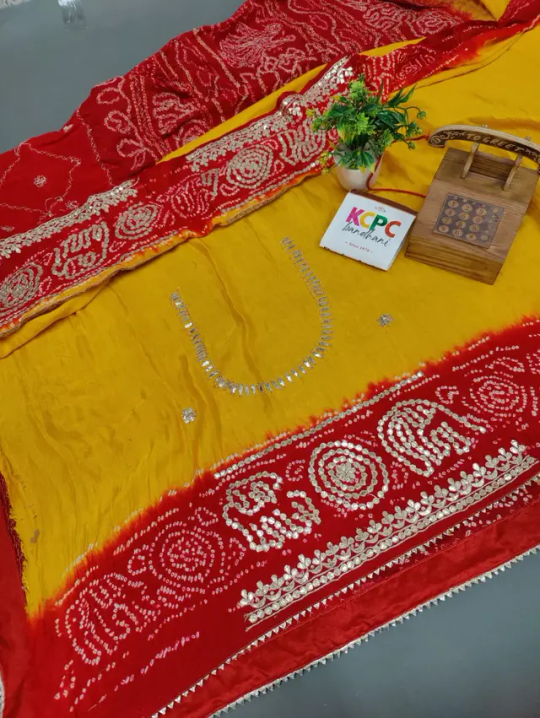


0 notes
Text
Pure Gajji Silk Bandhani Designer Party Wear Gotapatti Work Saree




A "Pure Gajji Silk Bandhani Designer Party Wear Gotapatti Work Saree" is a type of traditional Indian saree that combines various elements to create a beautiful and elegant outfit suitable for parties and special occasions. Let's break down the components of this saree:
Pure Gajji Silk: Gajji silk is a type of silk fabric known for its richness and smooth texture. It is often chosen for special occasion sarees due to its luxurious feel and appearance. It's a popular choice for bridal and party wear sarees. Bandhani: Bandhani is a traditional tie-dye technique originating from India, particularly in the regions of Rajasthan and Gujarat. In Bandhani, small portions of the fabric are tied with thread before dyeing, creating intricate patterns and designs. This results in a beautiful, colorful, and patterned fabric. Bandhani sarees are well-known for their vibrant and eye-catching designs. Designer Saree: A designer saree typically implies that it has been created by a fashion designer or artisan who has put special attention into its design, color combination, and overall aesthetics. These sarees often feature unique and fashionable elements that set them apart from regular sarees. Gotapatti Work: Gota Patti is a traditional Indian embroidery technique that originated in Rajasthan. It involves attaching pieces of gold or silver ribbon onto the fabric to create intricate and ornate patterns. Gotapatti work adds a touch of opulence and glamour to the saree, making it suitable for parties and weddings. In summary, a "Pure Gajji Silk Bandhani Designer Party Wear Gotapatti Work Saree" is a high-quality silk saree that combines the tie-dye Bandhani technique with designer elements and intricate Gotapatti embroidery. This combination results in a stunning and luxurious saree that is perfect for special occasions and parties, especially in Indian culture where sarees are a symbol of elegance and grace.
0 notes
Text
Pure Dola Silk With Patola Printed Gamthi Work Mirror Work Lace Lehenga






The "Pure Dola Silk With Patola Printed Gamthi Work Mirror Work Lace Lehenga" appears to be a traditional Indian lehenga made from high-quality Dola silk fabric and featuring various intricate design elements. Let's break down its components and details:
Pure Dola Silk: Dola silk is a premium and luxurious silk fabric known for its softness, sheen, and smooth texture. It is a favored choice for upscale ethnic wear due to its elegance and comfort.
Patola Printed: Patola is a traditional weaving technique originating from Gujarat, India. Patola prints often feature intricate and vibrant geometric or floral patterns. In this case, the lehenga incorporates Patola printed designs, adding a touch of cultural richness and artistry to the ensemble.
Gamthi Work: Gamthi work refers to the embroidery or decorative work that is typically found in Gujarat's traditional clothing. It can include intricate mirror work, beadwork, thread embroidery, and more. The presence of Gamthi work enhances the beauty and craftsmanship of the lehenga.
Mirror Work: Mirror work, also known as "shisha" or "abhla," is a traditional Indian embellishment technique where small pieces of mirrors are stitched onto the fabric in decorative patterns. It adds sparkle and a traditional touch to the lehenga.
Lace: The use of lace in the lehenga may serve as an additional decorative element. Lace is often used to edge the lehenga skirt or the dupatta, enhancing its overall appearance.
Lehenga: The lehenga itself is the flared skirt portion of the outfit. It is typically made from the pure Dola silk fabric, which ensures a luxurious and comfortable fit. The Patola prints, Gamthi work, mirror work, and lace details are likely incorporated into the design of the lehenga to create a visually appealing and culturally rich look.
Choli: A matching or contrasting blouse, known as the choli, is usually paired with the lehenga. The choli may also feature similar design elements to complement the lehenga's overall aesthetics.
Dupatta: A coordinating or contrasting dupatta (scarf) is often included with the lehenga ensemble. It can be draped over the shoulders or head, and it may feature the same design elements as the lehenga or have its own unique embellishments.
Occasion: Such a lehenga is likely designed for special occasions like weddings, festivals, or formal celebrations. Its use of traditional Indian textiles, prints, and embroidery techniques makes it a popular choice for grand events.
Availability: Lehengas like these can be found in specialized clothing stores, boutiques, or online retailers that focus on traditional Indian attire. They are often customized to the wearer's preferences regarding color, size, and design.
In summary, the "Pure Dola Silk With Patola Printed Gamthi Work Mirror Work Lace Lehenga" represents a fusion of traditional Indian craftsmanship and contemporary fashion. It is a stunning and culturally rich outfit choice, perfect for various festive and celebratory occasions.
1 note
·
View note